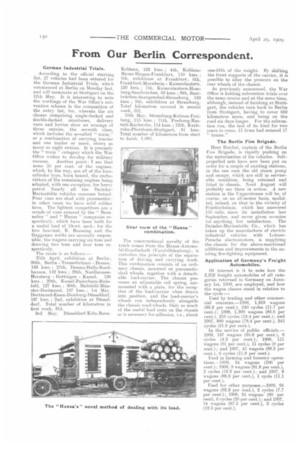From Our Berlin Correspondent.
Page 4

If you've noticed an error in this article please click here to report it so we can fix it.
German Industrial Trials.
According to the official starting list, 27 vehicles had been entered for the German Industrial Trials, which commenced at Berlin on Monday last, and will terminate at Stuttgart on the 12th May. It is interesting to note the workings of the War Office's subvention scheme in the composition of the entry list, for, whereas the six classes comprising single-decked and double-decked omnibuses, delivery vans and lorries show an average of three entries, the seventh class, which includes the so-called " train," or a combination of carrying tractor and one trailer or more, shows as many as eight entries. It is precisely the " train " category which the War Office wishes to develop for military reasons. Another point: I see that some 50 per cent, of the engines, which, by the way, are all of the fourcylinder type, burn benzol, the carburetters of the remaining engines being adapted, with one exception, for heavy petrol. Nearly all the Da imlerMarie/delde vehicles consume benzol. Four vans are shod with pneumatics : in other eases we have solid rubber tires. The lightest competitors are a couple of vans entered by the " Brennabor " and " Hansa " companies respectively, which have been built for a useful load of 10ewt. each; for the two heaviest, R. Buessing and the Gaggenau works are severally responsible, the wagons carrying six tons and drawing two tons and four tons respectively.
The route is as follows :— 25th April, exhibition at Berlin ; 26th, Berlin Treuenhritzen Dessau.
133 kms. ; 27th, Dessau-Halle-Nord hausen, 142 kms.; 28th, NordhausenHerzberg Gottingen Kassel, 138 kms.; 29th, Kassel-Paderborn-Bielefeld , 127 kms. ; 30th, Bielefeld-Miinster-Dortmund, 137 kms.; lst May. Dortmund-Essen-Di i islet rg-Dtisseldorf 137 kms. ; 2nd, exhibition at Dfisseldorf. Total number of 'kilometres in first week, 814.
3rd May, Dfisseldorf-Köln-Bonn
Koblenz, '129 kms.; 4th, KoblenzMainz-Bingen-Frankfurt, 110 kms. ; 5th, exhibition at Frankfurt; 6th, Frank furt-111annh eim Kaiserslautern, 120 kms.; 7th, Kaiserslautern-Homburg-Saarbriichen, 69 kms.; 8th, Saarbriichen-Saargemtind-Strassburg, 133 knis.; 9th, exhibition at Strassburg. Total kilometres covered in second week, .561.
10th May, Strassburg-Kolmas-Freiburg, 115 kms. ; 11th, Freiburg-Rastatt-Karlsruhe, 114 kms. ; 12th, Karlsruhe-Pforzheim-Stuttgart, 81 kms. Total number of kilometres from start to finish, 1.685.
The constructional novelty of the trials comes from the Hansa-Automobil-Gesellschaft (Varel-Oldenburg); it embodies the principle of the separation of driving and carrying work. This combination consists of an ordinary chassis, mounted on pneumaticshod wheels, together with a detachable load-carrier. The chassis possesses an adjustable coil spring, surmounted with a plate, for the reception of the load-carrier when drawn into position, and the load-carrier's wheels run independently alongside the chassis road-wheels. Only so much of the useful load rests on the chassis as is necessary for adhesion, i.e., about one-fifth of the weight. By shifting the front supports of the carrier, it is possible to alter the pressure on the rear wheels of the chassis.
As previously announced, the War Office is holding subvention trials over the same course and at the same time, although, instead of finishing at Stuttgart, the vehicles turn back to Berlin from Stuttgart, having to cover 669 kilometres more, and being on the road six days longer. For the subvention run, the last of its kind for two years to come, 11 firms had entered 17 " trains."
The Berlin Fire Brigade.
Herr Reichel, captain of the Berlin Fire Brigade, is rapidly pushing on the motorisation of his vehicles. Selfpropelled sets have now been put on order for a couple of existing stations, in the one case the old steam pump and escape, which are still in serviceable condition, being retained and fitted to chassis. Next August will probably see them in action. A new station in the Ungarstrasse will be, of course, on an all-motor basis, modelled, indeed, on that in the vicinity of Friedrichshain, which has answered 150 calls, since its installation last September, and never given occasion for anything but satisfaction. The Daimler-Marienfelde Co., which has taken up the manufacture of electric industrial vehicles with LohnerPorsche electromotors, is supplying the chassis for the above-mentioned additions and improvements to the existing fire-fighting equipment.
Application of Germany's Freight Automobiles.
Of interest is it to note how the 2,252 freight automobiles of all categories returned in Germany on January 1st, 1909, are employed, and how the wagon classes stand in relation to the cycle :
Used by trading and other commercial concerns.-1909, 1,819 wagons (88.3 per cent.), 240 cycles (11.7 per cent.); 1908, 1,399 wagons (86.6 per cent.), 216 cycles (13.4 per cent.); and 1907, 890 wagons (78.4 per cent.), 245 cycles (21.6 per cent.). In the service of public officials.1909, 137 wagons (95.8 per cent.), 6 cycles (4.2 per cent.); 1908, 111 wagons (91 per cent.), 11 cycles (9 per cent.); and 1907, 45 wagons (88.2 per cent.), 6 cycles (11.8 per cent.).
Used in farming and forestry operations.-1909, 24 wagons (100 per cent.); 1908, 9 wagons (81.8 per cent.), 2 cycles (18.2 per cent.); and 1907, 8 wagons (88.9 per cent.), 1 cycle (11.1 per cent.).
Used for other purposes.-1909, 24 wagons (92.3 per cent.), 2 cycles (7.7 per cent.); 1908. 24 wagons (80 per cent), 6 cycles (20 per cent.); and 1907, 14 wagons (87.5 per cent.), 2 cycles (12.5 per cent.).




















